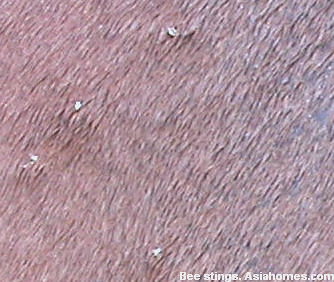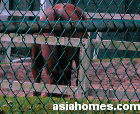Educational tips for pet lovers
The girl with sharp eyes and
steady hands
"The horse is trembling and unable to stand properly," said Ms Firn. "He
had been stung by hundreds of bees." She phoned up three times.
I imagined the horse developing an allergic reaction to the venom released by the
sting. One research on bee venom reported that melittin which causes the blood cells
to break down, lowers blood pressure and release histamine forms 50% of the venom.
Phospholipase A which cause cells to break down forms 12%. Hyaluronidase which breaks down
the connective tissue between cells forms 3%. Acid phosphatase which induces allergice
reacion and histamine which causes itchiness and pain, each form 1%.
I left my surgery immediately but the evening traffic on the expressway took me at least
fifteen minutes to reach the horse.
"Try and remove the bee stingers if you have long finger nails," I
said. "The horse had developed hives in its back end," Ms Firn
sounded urgent.
I was already in a cab I said. Some horses do become sensitive to bee stings if it
had been stung before. A mild allergic reaction manifested by itchy skin rashes all over
the body would not kill the horse. This horse shivered and
moved away from the association with increasing pain at the sting
sites.
The stings had detached from the body of the honey bee after stinging. It included part of
the bee's abdomen, along with a nerve ganglion, various muscles, and a venom sac.
The sting itself consisted of two lancets with curved barbs on the outer aspect of their
distal end, held in grooves on the stylet.
 Muscular movements of the detached sting, coordinated by the attached nerve ganglion,
moved the stylets alternately. The barbs anchored into the skin so that the sting
continues to work itself deeper into the flesh. A valve and piston on the
Muscular movements of the detached sting, coordinated by the attached nerve ganglion,
moved the stylets alternately. The barbs anchored into the skin so that the sting
continues to work itself deeper into the flesh. A valve and piston on the
proximal ends of the moving lancets pumped the venom from the venom sac between the stylet
and the lancets and through an opening near the tip into the wound.
Bee stings are seldom fatal unless the horse had a severe allergic reaction called an
anaphylactic shock. There were at least a hundred of stingers on the neck, the backside,
the limbs and the groin area and in between the hind legs. They looked like white circular
pins shining brightly on the brown skin of this horse.
Why would the bees attack the rider and the horse? The horse bolted with its rider
who was now under observation in a hospital. Did he crush the first bee on his face. The
bee's body would produce a pheromone which are chemicals to alert other bees to assist in
attacking him. Was the horse given sprays with a lemon or citus smell which attract bees?
I would not know.
Signs of shock would include pale mouth membranes, rapid pulse rate, rapid breathing, or
loss of consciousness, restlessness, anxiety or confusion. The horse was
restless. The horse was brought to the sand ring after being injected with a pain
killer, antibiotic and anti-allergic reaction.
The three teenaged girls helped to restrain the horse. The horse calmed down on hearing
their voices but he was partially doped by the pain killer injection.
"Can you tranquilise him?" one teenager asked me as she watched the horse
struggling and about to kick her. She was using the forceps to remove the stingers
from below the thigh of the horse, while holding on to the horse's tail with one
hand. The other stingers on the neck and sides of the horses were easily removed without
the danger of being kicked. Now, there were five stingers under the belly and in between
the back legs, on the upper thigh.
"The horse will not kick if I pull her tail," she advised me as she zeroed the
forceps onto another small white stinger. I wanted to use the nose twitch but her friend
said it was cruel.
She grasped it with the forceps and bounced the stinger off by hitting the forceps onto
her riding boots.
Sharp eyes and a steady hand are advantages of this fair and slim youth with the right
weight and height to qualify her to be a jockey. Jockeys should weigh less than 50 kg and
she was of the right weight. Fearless, not worried about falling off the horse.
These are excellent characteristics of a good jockey.
"The tranquiliser may lower the blood pressure," I said. "And the horse may
die of heart failure." A nose twitch to restrain the horse was not acceptable
to the ladies as it caused pain to the nose. Yet I did not want this teenager to be
killed by the horse. Holding on the tail may prevent kicking.
The bee stingers were not that large, about 3 mm in diameter. She was good at extraction
but the danger is great. The stable hand was called to help as he was a strong man. He
held up one front leg while the other girl gripped the skin of the neck.
Three more stingers lodge between the legs near the groin area. I insisted on the nose
twitch. The teenagers had their anti-cruelty ideas but this was time to be careful for the
plucky short and trim teenager who was going to take the risk to pull out the stingers.
Should they be left alone? They might develop into infected abscesses and irritate
the horse as that area on the upper thigh between the legs was thin skinned and
hairless.
 The nose twitch worked perfectly together with one front leg being
lifted up by the stablehand. The horse was really hungry and started to eat the grass
outside the lunging ring. It was late but bright November evening as I left in a cab,
grateful to the four expatriate youths who volunteered and especially to that slim youth
who risked being kicked to help a horse in distress and made sure that all stingers were
removed. The bees which stung the horse would die and the
authorities would be called to remove the nest up a tall tree in
this wooded and quiet area of Singapore. The nose twitch worked perfectly together with one front leg being
lifted up by the stablehand. The horse was really hungry and started to eat the grass
outside the lunging ring. It was late but bright November evening as I left in a cab,
grateful to the four expatriate youths who volunteered and especially to that slim youth
who risked being kicked to help a horse in distress and made sure that all stingers were
removed. The bees which stung the horse would die and the
authorities would be called to remove the nest up a tall tree in
this wooded and quiet area of Singapore.
Asiahomes Internet
asiahomes.com/singapore_classified
Blk 1002, Toa Payoh Lor 8, #01-1477,
Singapore 319074, Republic of Singapore
Mobile Tel: +65 9668 6468, 9668 6469
Tel: +65 6254 3326, 6254 2728
Fax: +65 6256 0501, 64545 843
Email: judy@asiahomes.com
|